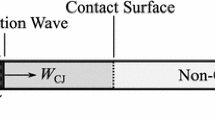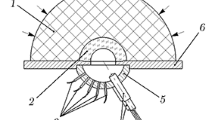Abstract
When a plane detonation propagating through an explosive comes into contact with a bounding explosive, different types of diffraction patterns, which may result in the transmission of a detonation into the bounding mixture, are observed. The nature of these diffraction patterns and the mode of detonation transmission depend on the properties of the primary and bounding explosives. An experimental and analytical study of such diffractions, which are fundamental to many explosive applications, has been conducted in a two channel shock tube, using H2-O2 mixtures of different equivalence ratios as the primary and bounding or secondary explosive. The combination of mixtures was varied from rich primary / lean secondary to lean primary / rich secondary since the nature of the diffraction was found to depend on whether the Chapman-Jouguet velocity of the primary mixture,D p, was greater than or less than that of the secondary mixture,D s. Schlieren framing photographs of the different diffraction patterns were obtained and used to measure shock and oblique detonation wave angles and velocities for the different diffraction patterns, and these were compared with the results of a steady-state shock-polar solution of the diffraction problem. Two basic types of diffraction and modes of detonation reinitiation were observed. WhenD p>D s, an oblique shock connecting the primary detonation to an oblique detonation in the secondary mixture was observed. WithD p<D s, two modes of reinitiation were observed. In some cases, ignition occurs behind the Mach reflection of the shock wave, which is transmitted into the secondary mixture when the primary detonation first comes into contact with it, from the walls of the shock tube. In other cases, a detonation is initiated in the secondary mixture when the reflected shock crosses the contact surface behind the incident detonation. These observed modes of Mach stem and contact surface ignition have also been observed in numerical simulations of layered detonation interactions, as has the combined oblique-shock oblique-detonation configuration whenD p>D s. WhenD p>D s, the primary wave acts like a wedge moving into the secondary mixture with velocityD p after steady state has been reached, a configuration which also arises in oblique-detonation ramjets and hypervelocity drivers.
Similar content being viewed by others
References
Ben-Dor G (1978) Regions and Transitions of Non-Stationary Shock Wave Diffractions in Perfect and Imperfect Gases, UTIAS Report No. 232
Dabora EK (1963) The Influence of a Compressible Boundary on the Propagation of Gaseous Detonations, Ph.D Thesis. The University of Michigan, Ann Arbor, Michigan
Dabora EK, Desbordes D, Guerraud C, Wagner HG (1991) Oblique Detonation at Hypersonic Velocities. In: Kuhl AL (ed) Dynamics of Explosions and Explosions: Detonations, Progress in Aeronautics and Astronautics. AIAA 133:187–201
Getzinger RW, Schott G (1973) Physical Chemistry of Fast Reactions. In:Levitt BP (ed) Physical Chemistry of Fast Reactions vol. 1; chap 2, 81–160
Gordon S, MacBride BJ (1971) Computer Program for Calculation of Complex Chemical Equilibrium Compositions, Rocket Performance, Incident and Reflected Shocks and Chapman-Jouguet Detonations, NASA SP-273, National Aeronautics and Space Administration, Washington, DC
Gvozdeva LG (1961) Refraction of Detonation Waves upon Incidence on the Interface of Gaseous Mixtures. ZhTF 31: No.6 pp 731–739
Gvozdeva LG, Predvoditeleva OA (1969) Investigation of Triple Configurations of Detonation Waves in Gases. Fizika goreniya i vzryva 5: 451–461
Jones DA., Sichel M., Oran ES (1995) Reignition of Detonations by Reflected Shocks, Shock Waves 5: 47–57
Lee JH, Glass II (1984) Pseudo-Stationary Oblique-Shock-Wave Reflections in Frozen and Equilibrium Air. Prog. Aerospace Sci. 21:33–80
Li C, Kailasanath K, Oran ES, Landsberg AM, Boris JP (1995) Dynamics of Oblique Detonations in Ram Accelerators, Shock Waves 5: 97–101
Liou, JJ (1986) Analysis of the Wave Interaction Between a Propagating Gaseous Detonation and a Bounding Explosive Layer, Ph.D. Thesis. The University of Michigan, Ann Arbor, Michigan
Liu JC, Liou JJ, Sichel M, Kauffman CW, Nicholls JA (1986) Diffraction and Transmission of a Detonation into a Bounding Explosive Layer. 21st Symposium (International) on Combustion
Oran ES, Jones DA, Sichel M (1992) Numerical Simulations of Detonation Transmission, Proc. R. Soc. Lond. A 436: 267–297
Sommers WP (1961) The Interaction of a Detonation Wave with an Inert Boundary, Ph.D Thesis. The University of Michigan, Ann Arbor, Michigan
White DR, Moore GE (1967), Eleventh Symposium (International) on Combustion. The Combustion Institute, Pittsburgh, p. 147
Author information
Authors and Affiliations
Rights and permissions
About this article
Cite this article
Tonello, N.A., Sichel, M. & Kauffman, C.W. Mechanisms of detonation transmission in layered H2-O2 mixtures. Shock Waves 5, 225–238 (1995). https://doi.org/10.1007/BF01419004
Received:
Accepted:
Issue Date:
DOI: https://doi.org/10.1007/BF01419004




